Baits for bream can be used in a variety of ways. When choosing them, experienced bream hunters take into account the specifics of the reservoir, the characteristics of the food and, of course, the time of year when fishing takes place.
All baits are conditionally divided into animal and vegetable origin. In addition, artificial baits are considered a special category.
The best vegetable baits for bream
Among the vegetable baits for bream, we highlight the most popular ones.
Steamed barley, which is often liked by large bream, is a good bait, but it is easy for small fish to take it off the hook. In addition, it does not withstand power casts. Because of this, pearl barley is used when fishing with float rods or on boards.
Corn or pea pretty common bait. She has a specific color and a spicy smell. It attracts fish well.
Among vegetable baits, it is the most popular. And the whole reason is its effectiveness. She has practically no flaws. The mixture does not become sour in water, “sits” well on the hook, and does not fall off during power casts. Just the last property is very important, because the bream lives far from the coast. Semolina is complemented by a variety of flavors for greater attractiveness.
canned corn breamers are not used very often. This lure is special. But it works very effectively on trophy bream.
Best Animal Lures
The standard bait is a worm. Suitable for the most different ways catching big fish. Just the worm provides an opportunity to fish out a trophy bream.
Maggot for catching bream is a bait for all occasions. It is resistant to small fish bites. A few maggots, planted on a hook, are an excellent delicacy for bream. The bait can be used at any time for all types of fishing. However, in some reservoirs, due to the nature of the food in winter, the bream will choose the bloodworm, not paying attention to the maggot.
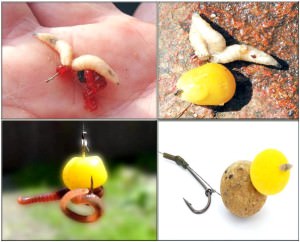
bloodworm- a bait that can be used with any methods of catching bream. It is effective in winter or in the warm season. It is best to use the bloodworm in the spring, at this time the bream is not interested in other types of baits. Well, in the summer you will have to show ingenuity, because the bloodworm attached to the hook attracts small fish and this is very annoying. So in the summer they rarely catch bloodworms.
The bream also catches the barn(dragonfly larva), this fish pecks at a caddisfly or at a small herbivorous clepsin leech. It is worth experimenting, because in different places the tastes of bream are different and it is often difficult to foresee them.
Sometimes experienced anglers also use more exotic baits, for example, cut toothless (barley). Its meat is cut into small cubes and slightly dried in the sun. There were cases when bream was caught on a piece of fat.
artificial lures
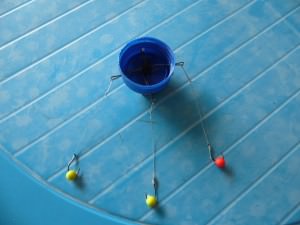
Styrofoam is a bait that can be used as an independent bait or to raise the hook above the bottom of a lake or river. As an independent bait, foam plastic is effective for feeder fishing; together with a feeder, it is used exclusively in water bodies where the current is very weak. The foam additive adds attractive vibrations to the hook, which are effective just in the current.
Dough pellets are dried dough casts threaded through with a piece of thread. Just in time for the thread, the pellet is fixed on the hook. Such a lure is effective in strong currents when fishing with side rods. If you use leashes of 1-2.5 meters, then the effectiveness of the bait increases greatly.
How to catch more?

For 7 years of active passion for fishing, I have found dozens of ways to improve the bite. Here are the most effective ones:
- Biting activator. This pheromone supplement is the strongest lure for fish in cold and warm water. .
- Raise gear sensitivity. Read the appropriate manuals for the particular type of tackle.
- Lures based pheromones.
Other Lures
A separate type of bream bait are boilies on a hair rig. This bait should measure 8-12 mm. If the size is smaller - it can peck small fish. In this case, both bottom and float gear are used.
Boilies can be bought, but you can cook them at home. The recipe is simple. You need to take 100 g of ground seeds, 10 g of sugar, 10 g of flour and 30 g of egg powder. From this, knead a thick dough, stand, roll into balls, boil, and then dry. The finished bait is folded into a plastic bag with the addition a small amount ground cake and placed in the refrigerator.

- barley and maggots;
- corn and worm;
- worms and maggots;
- bloodworm and worm (sometimes dough is added);
- moth and maggot.
Such combinations are very effective when fishing.
Features of the choice of bait and bait for bream
Depending on the season, the food preferences of the bream differ. So to catch him, you have to prepare different baits and baits.
bait in the spring
In early spring, the bream prefers maggots, bloodworms, caddisflies or worms. If the reservoir is rich in bloodworms, it is preferable to use this type of bait. For catching trophy bream, a worm is used, but for this the water should warm up a little. It is allowed to use different "sandwiches" from maggot and bloodworm, worm and maggot.
If the water warms up and spawning time is approaching, you can use vegetable baits: steamed barley and peas, canned corn, bread crumb, semolina or a master. Artificial baits such as Styrofoam and test pellets are also effective.
As for bait, be sure to use components that contain sugar: canned corn, the smell of cinnamon, vanilla, fennel, coriander.
A good effect is the addition of these components to millet, peas, hercules, pearl barley. You can also add some chopped worms. To form a cloud of turbidity, it is useful to add 2 a little cocoa. And fruit essence will add sweetness to the bait.
Bait in the summer
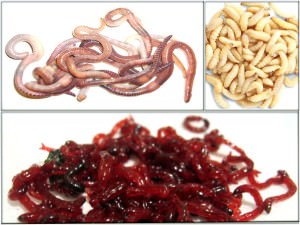
In summer, bream bites on baits of animal origin: bloodworm, maggot, worm. From vegetable baits, mastyrka, peas, corn and pearl barley are used. An excellent result is provided by a combination of mastyrka and a worm. Often flavored dough is added to them.
As for baits, you can use both branded and your own mixtures. The main ingredients in self-cooking bait: corn, crackers, millet, oatmeal and sunflower cake. Used to create a mule cloud and attract fish powdered milk. Good results and artificial flavors. But you can't overdo it.
Bait in autumn
In autumn, the bream gathers in flocks for fattening before winter. He is very careful. Experienced anglers recommend taking all available types of bait with you during this period and experimenting. After all, often the fish is capricious and bites uncertainly. It is best to use a bunch of bloodworms as a nozzle. Maggot or "sandwich" is also good: maggot and bloodworm. A large bream bites, as always, on a worm.
And of course - correct feeding. In autumn, it should have a lot of proteins, because the bream is trying to work up more fat. Therefore, it should contain maggot and bloodworms. The role of flavoring can be performed by the smell of thyme, it is better not to use others.
To attract large bream, you need to mix maggot, chopped worm and millet porridge with clay.
In addition, bait from bran, crackers and sunflower cake, to which bloodworms and maggots are added, gives a good effect.
Bait in winter
In winter, the bream bite is much weaker than in other periods. Practice shows that at this time it is possible to catch on baits of animal origin, however, in addition to maggot and bloodworm, you can also choose soft vegetable baits: steamed barley and dough. You can catch on "sandwiches": bloodworm and maggot.
Winter bait does not differ in diversity. Experts recommend completely abandoning flavors. The most effective simple baits: cake and bran, crackers, products familiar and effective with various additives millet porridge, hemp, pearl barley and peas. It is worth adding a small fodder bloodworm. But the quality of bait must be high. Crackers are better to choose from black bread and calcined before fishing, and then grind to a fine fraction.
The choice of bait according to the place of fishing
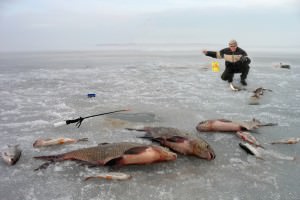
When fishing for bream on a river with a strong current, especially in wiring, it is best to use baits that can hold well on the hook. A good effect is provided by bloodworms, red worms, maggot pupae, grains barley groats or corn.
If bream fishing is carried out in the channel, you should choose a small bait. 4 maggots impaled on a hook or small red worms are best suited. Bloodworms and maggot pupae also provide a good effect.
When fishing on the lake, you should not use a small bait, otherwise small fish will bother you.
The most catchy baits on ponds without a current are:
- red worm or bunch of small red worm;
- part of the crawl, and if it bites big fish, then integer;
- pasta "horns";
- corn impaled on a hook for 2-4 grains;
- potato cubes, 1 cm in size;
- semolina dough;
- a bunch of maggot, but only in the absence of small fish.
When fishing in the reservoir, vegetable baits are used less frequently, giving way to animal baits.
Recipes for self-made bait for bream
AT summer time to attract large bream, the following bait is used. A little sugar and honey are added to the boiled barley. Also add a few drops sunflower oil. Then barley must be thoroughly mixed until the sugar and honey are completely dissolved. Honey-sunflower smell is an excellent bite activator during bream fishing. And the sweet taste will make the fish swallow the bait.
Bloodworm bread is also a good bait. It is prepared very simply: half a roll is kneaded with a bloodworm (about 100 g of larvae). The result should be homogeneous dough. For bream, such bread will be much tastier, and the bait can be used at any time of the year. After all, even in winter, this fish shows vegetarian preferences.
Another good bait is millet balls. To prepare them, you need to take 2 cups of milk, add a glass of millet and boil over low heat until completely dissolved. A teaspoon of honey is added to the resulting mixture and everything is thoroughly mixed. At the same time, you need to try to grind the grains until a pasty mixture is formed. Then the bait should be brought to the condition in the oven by setting a low fire. Before the finished bait cools down, add 5-6 drops of hemp oil to it.
Experienced reefers know the secrets that allow you to catch this cautious and rather capricious fish.
- Earth or dung worm is the most common bait for bream. Often this fish pecks at a giant worm - crawling out. The popularity of such a nozzle is due to its availability: the worm can be found almost everywhere.
- Among the baits when catching bream on the feeder, corn and unpeeled peas are in the lead. They do not attract small fish and are used to catch large bream.
- When using balls of semolina (also catchy bait), you need to make sure that the semolina is not loose, otherwise it will fly off the hook when it hits the water.
- The bloodworm is hung on the hook only with a bundle, which is connected using a special knitting device. This royal bait can be used at any time of the year in all water bodies.
These are the ingredients themselves and their ratio, the quality of the batch and the consistency, the season, the specifics of the reservoir and, of course, the taste habits of the species you are counting on. Adapting to these floating criteria for ready-made baits, despite their diversity, can be quite difficult, therefore fishermen often use only part of the finished bait, supplementing it with a mass of its own preparation.
In questions of where to start cooking and how to choose the right ingredients, do-it-yourself bait recipes for the feeder will help novice feeders. They can be used as a basis for creativity, but it must be borne in mind that a good bait performs a number of specific tasks that are achieved the right ratio components:
- after touching the bottom, the feeder explodes, creating a cloud of turbidity that spreads throughout the pond, advertising your treat;
- a bait spot of larger components keeps the fish that swim up in place.
If there is a good current and a sufficient number of fish in the reservoir, do not be afraid to overfeed future prey and weaken her interest in the bait.
Universal Recipe
Any feeder bait recipe includes a base and an additive. The task of the first is to provide stickiness and dustiness of the consistency, creating a cloud of edible particles. For the base you can use various interchangeable products. These are dry cereals, ground pastries and confectionery, grated cake, ground roasted peanuts or pumpkin seeds, hemp, coriander and sunflower seeds; oatmeal, fish flour, semolina, dry milk.
The additive is represented by larger fractions designed to keep fish within a small radius from the bait. The components of the additive should be moderately crumbly so that every fish that swims up can find something to eat.
Undercooked whole grains are suitable for these purposes: millet, barley, peas; boiled or canned corn, bran. It is generally accepted that barley and millet are better suited for feeding crucian carp and carp; bream prefers millet and peas.
The third component, added at will, are flavors and various flavor enhancers. To give the porridge a smell and additional palatability use fragrant oils and also sweet fruit syrups , honey, caramel, coffee, chocolate and cocoa. Of course, all these sweets have identical substitutes - they are cheaper than the original, so they are used more often.
The following do-it-yourself bait recipe for the feeder has a number of advantages:
- The versatility of the bait: the finished composition is suitable for catching carp, carp and bream.
- Availability and low cost of components.
- Minimum cooking time.
For the base we use the following ingredients:
- half of the volume is occupied by ground bakery products: these are crackers, the remains of cookies, gingerbread and sweet pastries;
- add 10 - 20% bran, rice and / or feed;
- 10 - 15% crushed sunflower cake;
- 10% semolina;
- 5 - 10% each of oatmeal (crushed oatmeal) and corn or any other finely ground cereals;
- and you can add some store-bought bait that matches the season and other criteria.
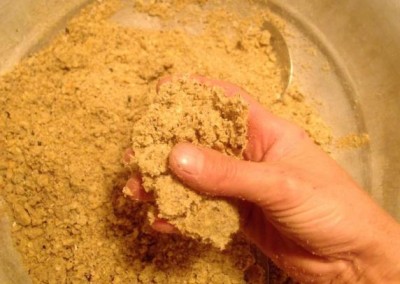 All components perform specific tasks, therefore, it is not worth deviating strongly from the indicated ratios. So ground bread, corn flour, oatmeal and semolina add viscosity to the mass. And bran, cake and other cereals are responsible for creating a cloud of turbidity and spreading an attractive smell throughout the reservoir.
All components perform specific tasks, therefore, it is not worth deviating strongly from the indicated ratios. So ground bread, corn flour, oatmeal and semolina add viscosity to the mass. And bran, cake and other cereals are responsible for creating a cloud of turbidity and spreading an attractive smell throughout the reservoir.
To the above ingredients can be in smaller quantities add crushed roasted sunflower seeds and peanuts, milk powder, ground flax and coriander seeds. Whole and crushed steamed hemp seeds are especially popular in the extraction of cyprinids.
On this, the preparation of the first part of the bait can be considered complete, or you can diversify the resulting paste with attractants. The flavoring of the bait mixture is carried out in advance or directly on the pond. Some smells, for example, oils, are better to include in the composition of porridge, because. they somewhat prevent the spread of the smell of other components.
For addition, any porridge is boiled: millet, barley, peas, pearl barley, you can add bran and corn.
The bases and additives are placed in the feeder in half, while mixing the components or laying them in layers is not very important. Much more important is the degree of tamping.- the feeder must be packed in such a way that the bait mixture is washed out in 5 - 10 minutes, otherwise the bait will not be effective.
Despite the versatility of the above recipe, the preparation of feeder bait for a particular type of fish has its own characteristics.
Bait for bream
For successful bream fishing when preparing bait, some aspects should be taken into account:
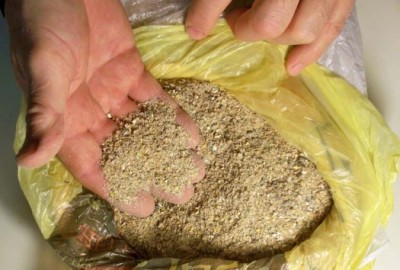
A good do-it-yourself bait for bream on a feeder necessarily includes peas, cake and crackers.
The following recipe has proven itself in summer fishing: it is necessary to mix 300 gr. boiled millet, bran and breadcrumbs, 200 gr. roasted and ground seeds, 2/3 tablespoons of ground coriander. After that, the mass is supplemented on the spot necessary quantity clay for optimum consistency.
Bait for carp
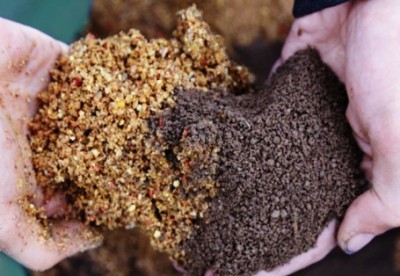 There is an opinion that crucian carp is a little less picky in the choice of food, but it should also be treated carefully. Carp loves animal components: adding chopped worm, bloodworm and maggot to the bait will increase your chances of a successful bite. In addition, you can cheer up sleepy fish using effervescent vitamins added right before casting.
There is an opinion that crucian carp is a little less picky in the choice of food, but it should also be treated carefully. Carp loves animal components: adding chopped worm, bloodworm and maggot to the bait will increase your chances of a successful bite. In addition, you can cheer up sleepy fish using effervescent vitamins added right before casting.
Bait for crucian carp should have a pleasant smell and taste, especially fish favors fruity aromas, the smell of vanilla and anise.
Good results are obtained by preparing the bait according to the following recipe.:
- 250 gr. oatmeal;
- 200 grams of ground crackers;
- 350 gr. ground cake or cake;
The bream is quite common in our reservoirs and an avid angler will never refuse such a coveted prey. But unlike most species of fish, the bream is a rather smart comrade, with good intuition and sheer enthusiasm it is difficult to get close to him. The key to successful fishing on it is experience, and if there is none, then high-quality bait for bream with your own hands will play a lot in this matter. important role.
Without proper preparation a bream may not hook on to you at all, or its biting will be purely random, so to prevent this from happening, we will describe in more detail its daily diet, seasonal preferences and actually teach you how to prepare bait.
The bream is a representative of the carp family, widely distributed in the basins of the Aral, Azov, Baltic, Black, and Caspian seas, inhabiting almost the entire territory of the former Soviet Union, Central and Northern Europe.
The bream loves deep-sea places with abundant underwater vegetation, prefers to stay in flocks. The peculiar structure of the mouth helps him to seek out food in soft ground.
- Young fry feed on plankton, but as they grow, they switch to benthos.
- The diet of adults is algae, larvae of various insects, snails, tubules and shells.
In areas with a strong current, as well as large lakes, bream tries to gather in large groups. The movement of the flock can be seen in the frequent small bubbles that float up from the bottom of the reservoir, when a group of hungry fish is cleaning the bottom in search of food.
AT winter period the fish prefers to huddle in deep-water places, and if the bream lives in the mouth of the river, then it often goes to sea for the winter.
Winter food recipes
The bait for bream can be different, sometimes fish can be attracted to the most unusual things, with which, perhaps, we will start.
Pebbles as bait
Old-timers sometimes use completely non-standard methods to attract the attention of large individuals, in this case helps ordinary pebbles.
A light cover of stone on a dark area of the bottom can significantly increase the catch, as the unusual color attracts the attention of hungry fish. In search of food, having stumbled upon a round light pellet, the bream begins to carefully probe the bottom, focusing on one place.
Important! The main thing is not to overdo it with the dimensions and the number of pebbles.
Bait with pea flavor
Bait for bream with a light pea aroma shows itself well.
In winter, the water of the reservoir becomes more transparent than usual, so an additional factor in a good catch is not only bait, but also the creation of a certain turbidity for it.
The composition of the ingredients is as follows:
- Breadcrumbs (700-750 grams).
- Fried sunflower seeds (75-80 grams).
- Pea groats (200-250 g).
- Oatmeal (90-100 g).
Making bait for bream is quite simple, for this we only need time, as well as a little patience.
At the bottom of the beginning, we pour the peas into an iron container and fill it with water (the peas should be twice less water). Bring the contents to a boil, then cover with a lid and leave to cook over low heat. Do not forget to stir from time to time so that the peas turn into boiled porridge, but do not burn.
Important! Fish are repelled by the smell of burning.
While our porridge is cooking, you can prepare dry ingredients. The first thing we need is breadcrumbs, you can use both store-bought and homemade.
Homemade breadcrumbs are not a problem, as they are easy to make:
- We dry bread, cookies, loaves, etc. in advance.
- Thoroughly grind the crackers with a meat grinder.
Then we take oatmeal and also pass through a meat grinder, you can use a blender or coffee grinder. It is this ingredient that gives a good white sediment in the water, which serves as an object of attention for fish.
Now we need roasted seeds. If you make them yourself, then try not to overcook, it is better to slightly underexpose than vice versa.
We pass them through a meat grinder or grind them in a coffee grinder (blender). Due to their properties, the seeds will emphasize the smell of the bait, maintaining a cloudy sediment in the water.
So, when all the dry ingredients are prepared, we proceed to the next step:
- We pour them into one container and begin to mix thoroughly, after which we pour in the already slightly cooled porridge.
- We knead the contents again and get a slightly dry bait, crackers absorb the liquid over time and become softer.
- To give a special flavor to complementary foods, you can add the essence of coriander, cinnamon or garlic smell.
We sculpt the prepared lure with a small ball, which, after a little pressure, should disintegrate.
Important! Already on the spot, you can add 100 g of bloodworm to the composition, and if mormysh is found in the fishing area, then it is better to use it.
Wheat-moth dish
The recipe for bait for bream consists of:
- Millet groats - 250 g.
- Motyl - 350 g.
- Cornmeal - 200 g.
- Hemp or sunflower cake.
We cook porridge in the same way as peas. Bring to a boil, then slow fire(do not forget to stir). When the porridge is ready and slightly cooled, add cornmeal and fresh cake, and just before fishing.
The composition of the recipe, depending on the fauna of the reservoir, is better to dilute with 200-250 grams of mormysh.
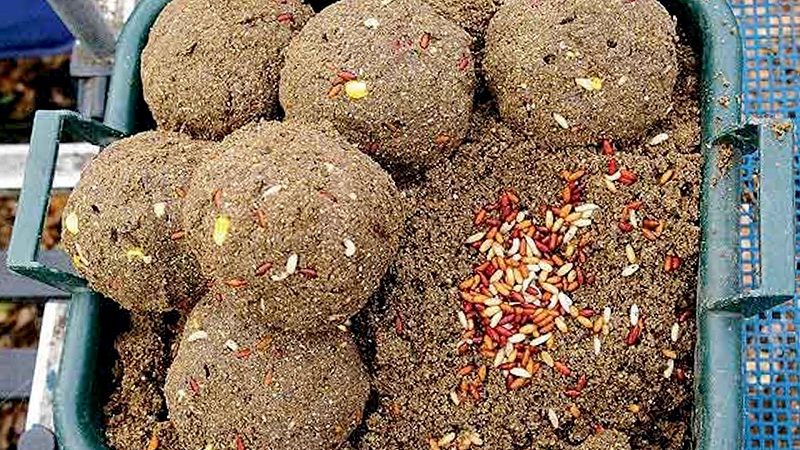
Photo 1. Balls with maggot and caster.
Assorted cereals
The composition of this bait includes a whole range of different cereals:
- Peas - 100 g.
- Buckwheat - 150 g.
- Pearl barley - 100 g.
- Hemp seeds - 50 g.
- Cornmeal - 200 g.
- Breadcrumbs - 250 g.
First, grind the peas separately with a coffee grinder or blender and set aside. Next, we grind barley, buckwheat and hemp seeds, after which we put it on a roast. Stir constantly and watch to make sure they don't burn.
After frying, we pass them several times through a meat grinder and mix thoroughly with the rest of the ingredients. Before feeding, the mixture should be slightly diluted with water, let the moisture accumulate for 10-15 minutes, after which you can start feeding.

Photo 2. Porridge from different cereals.
Top dressing in the spring
In spring, the bream moves a lot and prefers not to stay in one place for a long time, ideally one could find a feeding place for fish, but if the search was unsuccessful, then we will try spring recipes to lure the fish.
Which fish will refuse animal-based complementary foods: bloodworm, chopped worm, maggot or mormysh? But in spring, a true sweet tooth wakes up in a bream, so it’s better to prepare bait for bream as follows:
- You can use canned corn flavored with cinnamon, coriander, or vanilla.
- A mixture of peas with the addition of raspberry pear or banana flavor works well.
- Barley mixed with oatmeal flavored with fruit essence is also a great option.
If you still prefer meat lure, then the best bait is the same bloodworm mixed with coastal soil.
Feeding for the summer season
In early June, the bream completely switches to plant foods. At this time of the year, it is better to prepare the bait from well-steamed grains and cereals: peas, roasted buckwheat, millet, etc. Bran steamed overnight is also good.
This season bream goes well with baits with anise and fruit flavors, sometimes prefers the smell of dill.
Closer to autumn, it can savor slightly fried lard and again switch to meat complementary foods.
Autumn top dressing
In autumn, the bream becomes extremely cautious and almost does not leave their homes, so it will definitely not work to feed the fish in the areas and no bait for the bream will help here. During this period, you need to feed the fish only at one specific point, exactly where it feeds.
In autumn, bream prefers meat food, although it goes well for cereals.
Important! Bream complementary foods in the autumn should be strictly one fractional.
Autumn porridge
The composition of this bait is as follows:
- Oatmeal - 200-250 g.
- Millet - 200-250 g.
- Fried sunflower seeds - 120-150 g.
- Hemp seeds - 120-150 g.
- Breadcrumbs - 400-500 g.
- Vanillin - half a teaspoon.
Cook a mixture of cereals over low heat and bring to a viscous gruel, and mix sunflower and hemp seeds and lightly fry. Do not forget that nothing burns.
The next stage of preparation is done directly on the spot, where we mix our food and add some coastal sand, clay and water, you can flavor it with fennel, garlic or coriander. We fill the made lure with chopped worm, bloodworm or maggot.
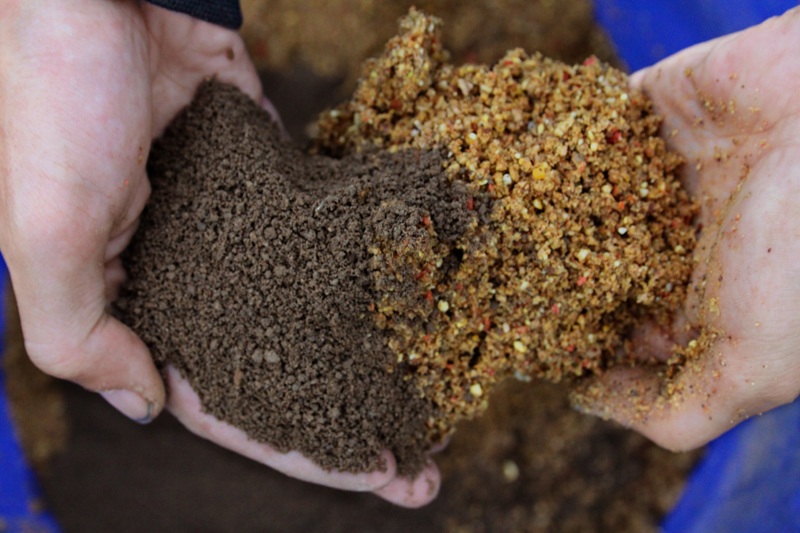
Photo 3. It is useful to deplete and weight the autumn mixture by adding soil.
Fishing features
A good bream is not only a cautious fish, but also wayward. An unusual factor is that for several days in a row he will go for only one bait and suddenly the bite disappears sharply, so it is better to prepare several types of complementary foods at once in advance.
At such moments, no one will undertake to accurately predict what the bream will prefer, one thing is definitely clear - the bream loves complementary foods, where there are larger components.
The advantage of such complementary foods is resistance to flow. For example, in the case of water movement from the place of feeding, it does not particularly carry it away, and the large bream goes to it. Clay will also be a good ingredient, which will not allow you to demolish mouth-watering pieces from the place of fishing.
And in stagnant waters dry mixes and good old pea porridge are better.
Bream is a pleasant prey, so if you are going for a good catch, do not forget that the bait for bream must include exactly the bait that you will fish with.
Finding the location of a bream in a pond is not so easy even for experienced fishermen. An adult, experienced bream is generally very shy and immediately swims away from everything that seems very suspicious to it. Even the rustling of a jacket on the shore terrifies him. Therefore, the fisherman must behave quietly, not make noise and not attract undue attention to his person from the fish population. And in order to attract him to the place of fishing and keep him there for the whole time of fishing, the angler uses delicious fragrant bait.
Without bait, the biting of bream will be random, which will make fishing boring, uninteresting and ineffective. Now we will talk about what kind of dressing will attract bream, and which, on the contrary, can scare it away; how the color, smell and consistency of baits affect the activity of biting; learn best recipes cooking bait and learn how to make lures for catching bream at different times of the year.
Good bait for bream. What is she?
There is no exact answer to this question. Since the tastes and preferences of bream are influenced by weather conditions, season, excess / lack of food in this reservoir, etc. But still, the basic principles for preparing good bait exist.
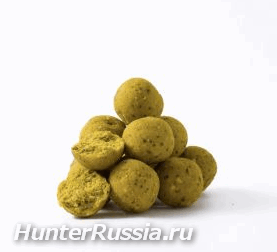 First, it must be fragrant. The bream should feel its appetizing smell. But still, you need to be careful with flavors. A very strong smell repels bream.
First, it must be fragrant. The bream should feel its appetizing smell. But still, you need to be careful with flavors. A very strong smell repels bream.
Secondly, feeding should consist of those products that this fish likes. The ingredients for bait will be discussed below.
Thirdly, all ingredients must be evenly mixed and ground. If there are large components in the bait (for example, peas), then the fish will quickly get enough and bite less willingly. So we grind all the large components of the top dressing (we scroll the seeds in a meat grinder, pearl barley can be kneaded by hands, etc.)
But too small, I would say, "powder" additives (powdered milk, cocoa in large quantities etc.) is also not good, since they form a large “cloud” of dust in the place where bream is caught, on which flocks of roach, rudd and other trifles flock. And they can interfere with us by climbing on the hook instead of scavengers and their adult comrades.
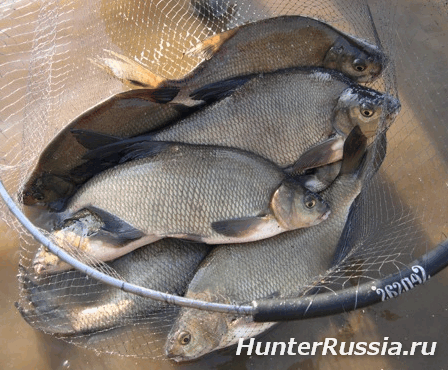
Bait for catching bream on the river should be dense and viscous so that it is not washed away and carried away by the current. Making the bait viscous is very simple - for this you need to add a little oatmeal porridge or clay.
It is very bad if the bait is very dry and breaks on the water. Ideally, it should fall to the bottom like a stone. And already at the bottom, gradually, within a few minutes, crumble. Therefore, before casting the bait to the right place, we should check how it will behave in the water by throwing a couple of lumps near the shore. You can also watch a video on the preparation and application of baits for bream and white bream.
Well, and another very important point that all novice fishermen need to know: the bait must contain what we are catching bream today. If we have a worm on the hook, then it must be added to the top dressing, if corn, then we add it in crushed form, etc.

A little about the color of the lure. Every angler has their own opinion about color. Someone uses the lure of bright colors (for example, red), while the other, on the contrary, is dark. But it is reliably known that large breams are scared away by a sharp contrast in the color of the bottom and top dressing lying on it. The color of the food can be changed with the help of special dyes, which are sold in any fishing store. You can also give the bait the color of a reservoir by adding a little silt or clay taken from the same reservoir.
In late autumn, winter and spring, hungry bream goes well with the smell of worms, bloodworms and other animal organisms. At the same time, before adding to the bait, the worms are chopped into small pieces, and part of the bloodworm is crushed. In the summer, in the heat, when the water temperature warms up above 18 0 C, the bream switches to vegetable food, and there is no need to add large quantities of earthworm or bloodworm to the top dressing.
Homemade bait recipes for bream.
We have learned all the most important things about feeding, now you can go to the recipes and the list of those products that attract bream. In fact, a good hundred more items can be added to this list of “food”, it all depends on the imagination of the fisherman.
- compound feed,
- Breadcrumbs,
- Millet porridge,
- Porridge "Hercules",
- Bran,
- Pearl barley,
- Oatmeal,
- Peanut,
- Corn flour,
- Peas,
- Sugar,
- Cake,
- crushed seeds (preferably roasted)
- sweet corn flakes,
- Barley porridge,
- Cookie,
- Maggot,
- Chopped dung worms,
- bloodworm,
- Etc.
Flavorings for bream.
 To give the dressing a pleasant aroma, various flavors are added to it. With them, the main thing is not to overdo it. Flavors (attractants) for bream can be bought at the store. If they are used in accordance with the instructions, then the smell of the attractant will attract a lot of fish to the place of fishing and the bite will be very frequent.
To give the dressing a pleasant aroma, various flavors are added to it. With them, the main thing is not to overdo it. Flavors (attractants) for bream can be bought at the store. If they are used in accordance with the instructions, then the smell of the attractant will attract a lot of fish to the place of fishing and the bite will be very frequent.
However, branded attractants have a more economical, but no less effective alternative. Here is a list of aromatic substances that attract bream:
- Vanilla,
- Anise (anise oil),
- Cinnamon,
- Coriander,
- Carnation,
- Leaves, shoots and roots of fennel,
- Garlic
- Strawberry, strawberry
- Pear
- Banana
- fruit essences
- And etc.
Recipe for summer bait for bream and bream:
Boiled millet groats - 1 part;
Bran - 2 parts;
Ground seeds - 2 parts;
One of the flavors.
Or here is another recipe:
Breadcrumbs - 2 parts;
Rice, boiled over low heat - 3 parts;
Roasted sunflower seeds, crushed - 3 parts;
Bloodworm and / or dung worm - 2 small handfuls;
Any of the above flavors.
The recipe for bait for catching bream in the fall:
Millet porridge - 1 part;
Bran - 1 part;
Breadcrumbs - 1 part;
Compound feed - 1 part;
Crushed peanuts - 1 part;
Feed bloodworm - 2-3 handfuls;
Flavor;
Clay or silt to give lumps of bait the desired density and viscosity.
These recipes are given as an example, in fact there are many more and you can come up with your own. perfect recipe using this list of ingredients and flavors.
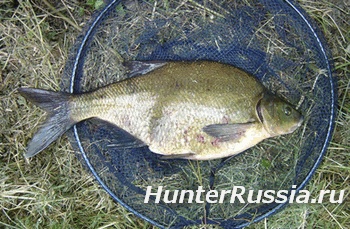 The recipe for feeding for catching bream in winter is as simple as two and two. Several handfuls of bloodworms are thrown under the ice. Sometimes it is mixed with some kind of porridge and bran.
The recipe for feeding for catching bream in winter is as simple as two and two. Several handfuls of bloodworms are thrown under the ice. Sometimes it is mixed with some kind of porridge and bran.
Bream should be fed immediately before and during fishing. The place where you are going to go fishing can be baited a few hours before fishing. If you go fishing early in the morning, you can cast a few bait balls late in the evening. True, this will already be called a bait.
In this article, you learned how to make a good bait that will attract rather than repel bream, and also got acquainted with some bait recipes. I wish you success on the pond and big catches!
Some men love to spend time with friends, especially if their common favorite pastime is fishing. The desire to get the coveted trophy - sometimes, it comes first.
Lure for bream: secret secrets of successful fishing
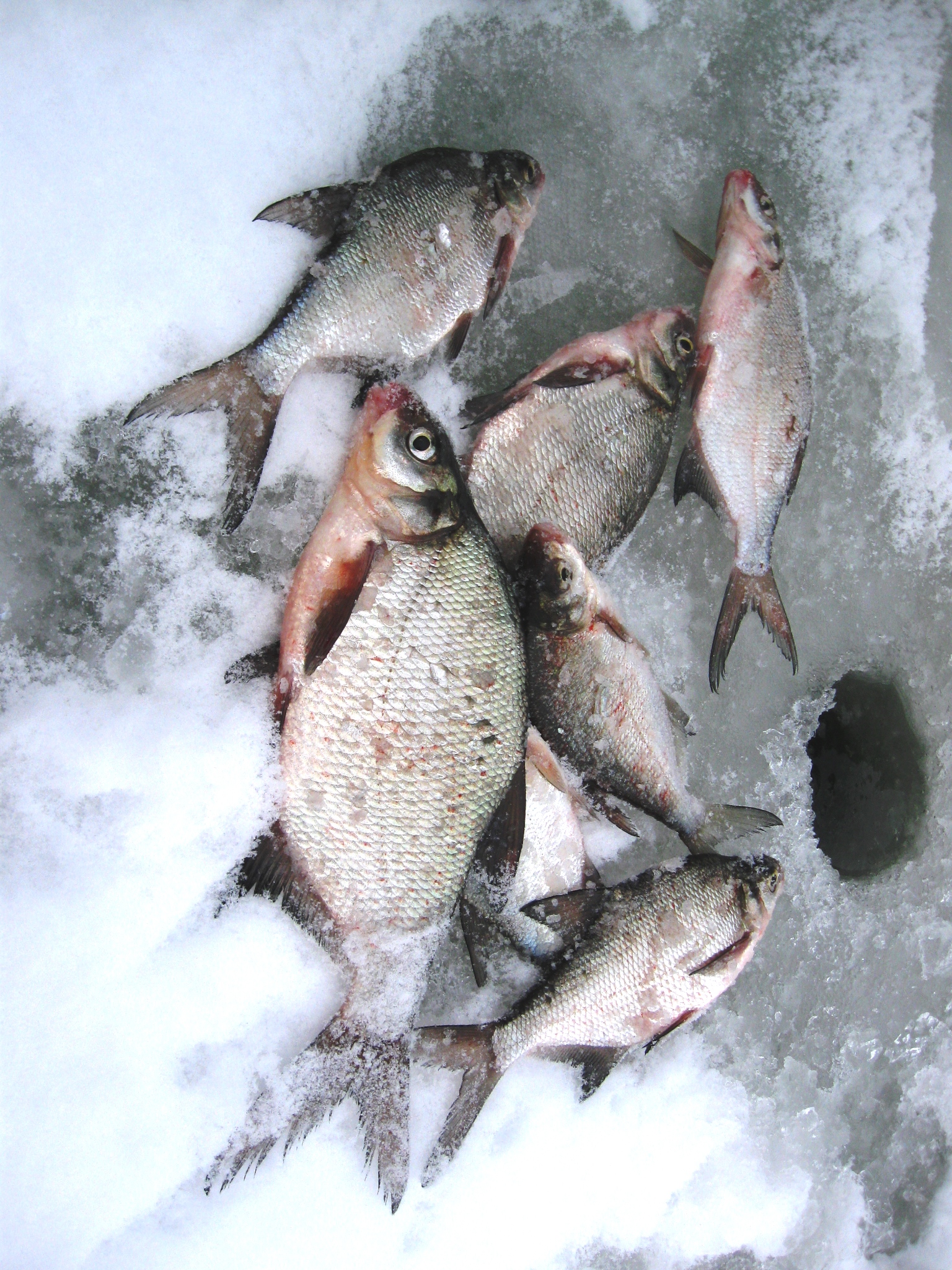 Fishing for all types of fish, including peaceful ones, is not a true fisherman without food. Basically, the fish is scattered throughout the reservoir, so it will be problematic to attract it to the baited hook.
Fishing for all types of fish, including peaceful ones, is not a true fisherman without food. Basically, the fish is scattered throughout the reservoir, so it will be problematic to attract it to the baited hook.
It is important to remember that each type of fish has its own taste preferences: what perch does not like, for example, crucian simply loves, etc. In this article we will talk about bait for bream, what taste preferences this fish has.
This "representative of the reservoir" has very developed taste buds, so a delicate taste distinguishes bream. The choice of all components must be approached very responsibly, of course, if you do not want to come into the house empty-handed. A very important role is played by the flavoring in bait, but too strong a smell can alert or even scare away the fish.
Purchased mixes or homemade bait?
Many inexperienced fishermen are concerned about the question, which bait is better to give preference to: branded purchased ones or still delicious, homemade?
So, let's figure out which baits work with a bang. It can be argued that finding the perfect mixture is almost impossible. Bait in one pond, which fish gather like bees for honey, may be completely useless in another pond.
It is also important to take into account the fact that the fish itself is not averse to tasting. After all, she is sometimes very capricious. Today she likes sweet aromas, and tomorrow serve garlic or cereals. Such things depend on the weather, the lack of food supply.
Shop bait - not the best the best option for baiting bream, because in this case we will not take into account the tastes of the fish. It is better to make a choice in favor of homemade, fragrant, tasty and crumbly bait, which no fish will definitely refuse.
The composition of the bait should include ingredients that are ideal for a particular fish. The main thing is to grind and mix the products well. So homemade bait works a hundred times more effective.
Components of bait
For every fisherman, the main goal is to increase the chances of attracting fish. For this, of course, flavors are created, but do not overdo it, because this way you can scare away the fish. The bait should consist of foods that the fish love the most.
The main components of complementary foods include:
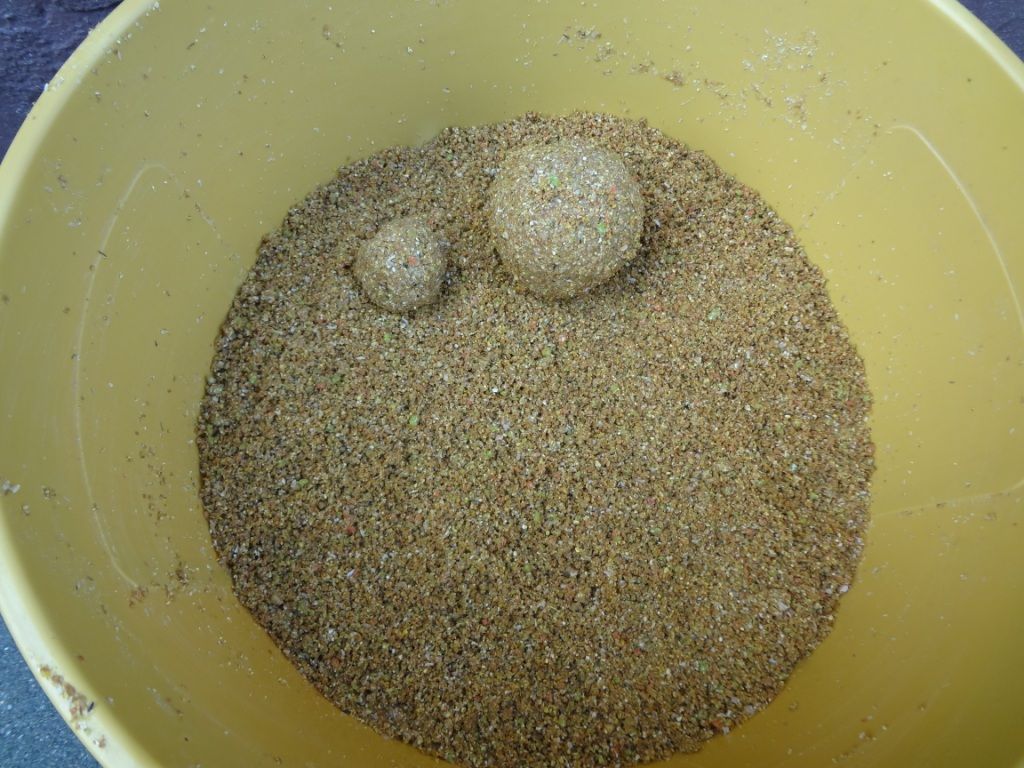
Do-it-yourself food preparation
Bait for bream can be the most versatile and it all depends on the season. The thing is that the behavior of fish at different times of the year tends to change. For example, summer top dressing will not work so smoothly in the winter.
Recipe number 1 (summer on still water)
This recipe is designed for baiting bream in the summer. To prepare it, we need to apply:
- Bran - 300 grams;
- Breadcrumbs - 300 grams;
- Ground coriander - 0.5 teaspoon;
- To the best of roasted sunflower seeds - 200 grams;
- Boiled millet in the amount of 300 grams;
- Clay to form the desired consistency.
Recipe number 2 (summer version for the river)
 Such a magnificent bait will definitely appeal to the bream. It is advisable to use it for fishing on the river in summer. So, for its preparation take:
Such a magnificent bait will definitely appeal to the bream. It is advisable to use it for fishing on the river in summer. So, for its preparation take:
- Breadcrumbs - 100 grams;
- Cake, including sunflower seeds - 200 grams;
- Sprouted peas - 200 grams;
- Ground coriander - 3 teaspoons;
- Oatmeal flakes - 200 grams;
- Clay.
Recipe number 3 (spring bait)
Spring is the time of awakening everything around, therefore fishing in this flowering, full of harmony season will bring real pleasure. Spring bait includes the following components:
How to catch more fish?
I have been active fishing for quite some time and have found many ways to improve the bite. And here are the most effective ones:- . Attracts fish in cold and warm water with the help of pheromones included in the composition and stimulates their appetite. It's a pity that Rosprirodnadzor wants to ban its sale.
- More sensitive gear. About reviews and instructions for other types of gear you can find on the pages of my site.
- Lures using pheromones.
- Boiled millet - 100 grams;
- Ground coriander - 2 tablespoons;
- Cake - 0.1 kg;
- Rye bran - 100 grams;
- Stern bloodworm - 3 matchboxes;
- Rye bran - 100 grams;
- Clay, sand.
Recipe number 4 (autumn bait for the current)
In autumn, it's time to take a break from everyday worries and carve out a few hours for a pleasant activity for the soul - fishing. Let's look at a variation of bait that is suitable for catching peaceful fish in a strong and frisky current. In order to prepare this lure, you need to take the following ingredients:
- Rye bran - 100 grams;
- Boiled rice - 0.1 kg;
- Sunflower cake - 100 grams;
- Lightly salted lard - 50 grams;
- Ground coriander is enough for 1 teaspoon;
- Bloodworms - 2 boxes;
- clay;
- Breadcrumbs - 100 grams.
Feeder bait for bream
The bream is a fairly large fish, it is characterized by caution and a sharp sense of smell, it is found in the reservoirs of the middle zone. A bright representative of the carp family is a coveted trophy for most fishermen, you will not be able to feel real taste fishing and experience joy if you don't catch this fish. Bream can be caught in many ways, for example, on a float rod or on an airborne one, directly from a rubber boat.
Fishing for bream on a feeder is one of the most famous methods for both beginners in the fishing industry and experienced pros. Thanks to this method it is possible to achieve unparalleled results in terms of weight and size of specimens. This method is most suitable for fishing in October, in November, but subject to the absence of freezing.
The feeder is a tackle represented by a specialized fishing rod and an equipped feeder. It is in the feeder that the bait is placed in order for the fishing to be catchy. The feeder equipment must also be equipped with hooks, on which it will be possible to pick up the bait. Masters who know everything in fishing have already been introduced to these innovations, because this system was actively used on bottoms in order to catch carp or bream.
The bream bites more intensively on the feeder starting from the end of April. In the autumn, you can make bream a very real prey.
Flavorings for bait
Bream and other fish rush to the bait if a pleasant aroma is emitted from it. Therefore, in order to give appetizing smells to the dressing, flavors were invented that will certainly attract fish. The main thing is not to overdo it with the number of flavors, or as they are also called attractants. The bream begins to smell any fragrant smells at long distances, which makes it swim straight to the place of fishing. However, branded flavorings can be successfully replaced by analogues - no less effective and budgetary in terms of cost.
The favorite smells of bream are anise, strawberry, but best of all it responds to sweet vanilla. By the way, sweet aromas can attract other fish, so be prepared for an unexpected surprise.
Also, to improve the properties of food bait, fishermen use the following attractants:
- Garlic.
- Ground dill. It is recommended to add it in the amount of 3 teaspoons per 1 kg of bait.
- Carnation.
- Coriander. It has a sharp, but at the same time appetizing aroma.
- pear.
- Strawberries.
- Shoot and root of fennel.
- Fruit essence.
- Banana.
Liquid fruit flavors such as apricot, strawberry, banana are madly in love with the bream. He also reacts positively to caramel, cocoa or anise.
Rules for feeding bream
The habitat of the bream is mainly rivers, where the stormy, unshakable current prevails. The fisherman needs to make sure that the bait settles to the bottom, and does not blur over long distances.
Feeding bream with a feeder
If there is a strong current in the pond, use bulky feeders from 90 grams. It is recommended to throw them against the current under a relatively small degree. The list of obligatory cases includes basing a landmark on the opposite bank. While the feeder, along with the bait, fell into the water, the rod is placed in its original state. At the same time, it is not necessary to wind the line at all. In this way, we will ensure that the bait will take a dotted position over and over again.
Feeding lumps when fishing with a float rod
If your plans include catching bream in a pond on a float, then it is recommended to deliver the bait by throwing lumps. It is necessary to include clay in the composition of the bait so that it makes the bait heavier. Thus, the bait sinks to the bottom in the shortest possible time. In addition, you can give preference to a mesh feeder with a float on a rope. The rope taking the path from the hands to the ring on the feeder, passing through the ring, reaches the float. Now you will always have information where the feeder is located. The chances of hooking the feeder with a hook will decrease significantly, of course, if you strive to throw the float equipment 0.5 meters further from the feeder float.


